1854: The year that shaped Melbourne |
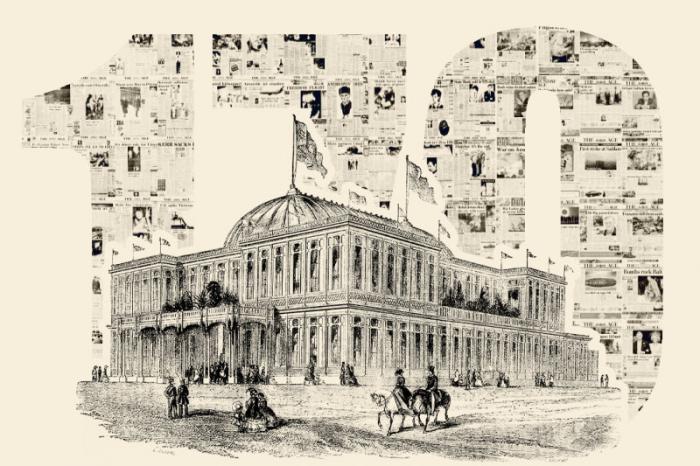
1854 was an amazing year in the shaping of Melbourne as this wonderful article by Tony Wright (TheAge) published in 2024 shows.
Celebrating 170 years of The Age, first printed in 1854.
The Age 170th birthday: Looking back at 1854
'Melbourne was leaping out of its skin': A new Age began in the year that shaped our city
The Melbourne we know today began to take shape in 1854. It was also the year The Age was first published. As we celebrate our 170th anniversary, we look back at this extraordinary year.
Just 19 years after John Batman and John Pascoe Fawkner sailed separately from Tasmania and set to years of squabbling about the right to be called the first white settler of the place that would become Melbourne, the citizens couldn't care less about old arguments.
Melbourne was leaping out of its skin, grabbing the future with eager hands and paying for it in gold.
It was 1854.
In that one tumultuous year, the essential rootstock that would eventually grow and blossom into the Melbourne we know today was grafted onto the landscape.
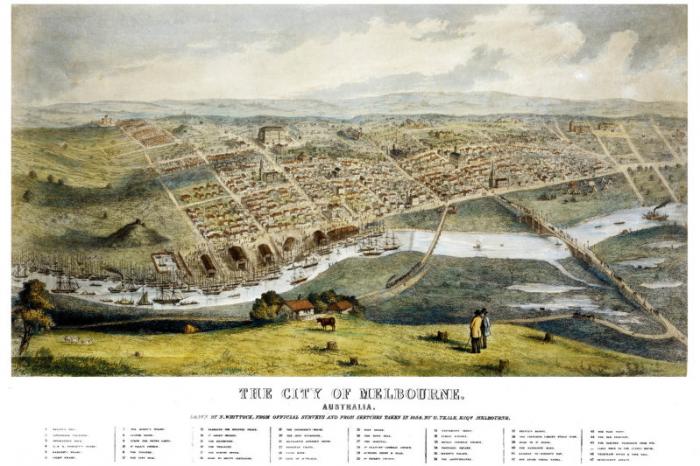
The MCG, Flinders Street railway station, Port Melbourne's Station Pier, the University of Melbourne, the Melbourne Museum, the State Library: all of these and many more venerated Melbourne landmarks got their modest start in 1854.
The thirsty citizens of Melbourne got their first public water supply in 1854, too, when a 150,000-gallon tank was built in East Melbourne, initially storing water raised by steam pump from the Yarra River before the Yan Yean Reservoir came on stream three years later.
Australian history was being made in other ways on the goldfields that were feeding Melbourne's wealth.
Before the year was done, out on the Ballarat diggings, a ragtag gathering of miners fed up with unjust treatment from the colonial authorities made the Eureka Stockade and the Eureka flag hopelessly romantic symbols of rebellion within the Australian story.
And yes.
The first edition of The Age was published on October 17, 1854.
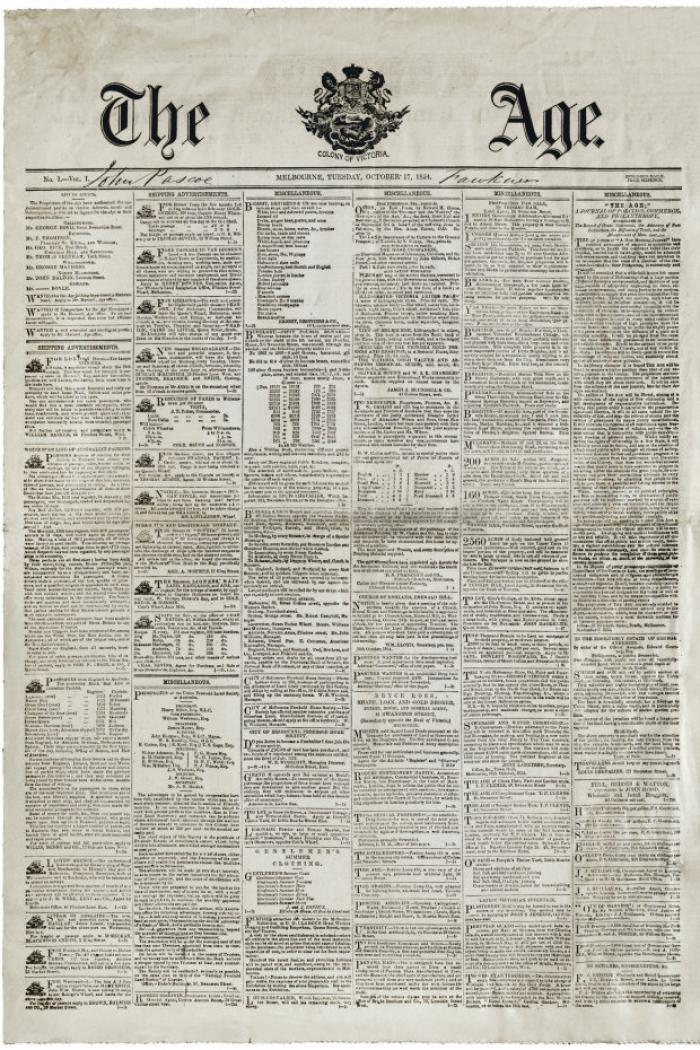
The 'Crystal Palace'
Grandly, the first edition was printed on a steam press set up within Melbourne's vainest pursuit of glory: the city's first exhibition building, designed to emulate London's stupendous Crystal Palace.
London's Crystal Palace, 990,000 square feet (92,000 square metres) of plate glass and cast iron, was the site of the Great Exhibition of 1851, the first of a series of world fairs that excited the imagination of the planet in the second half of the 19th century.
The leading boosters of flourishing Melbourne allowed their enthusiasm to set off at a gallop: if London could do it, why not Melbourne?
Melbourne's "Crystal Palace" was constructed of glass and wood on the corner of William and La Trobe streets, boasted just 23,000 square feet (2140 square metres) of floor space, and was built in 70 days.
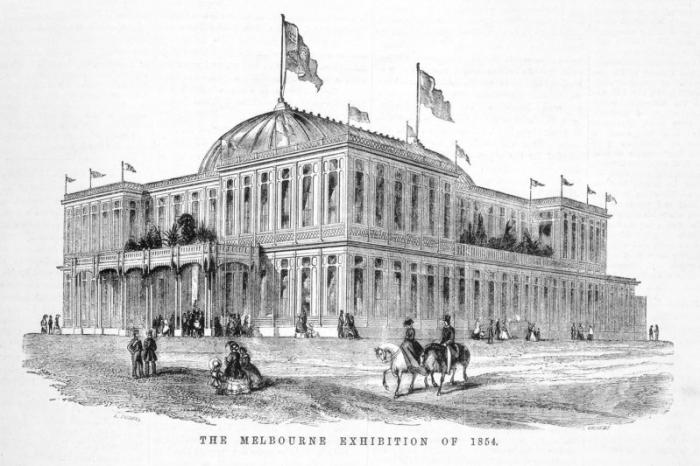
It may not have been quite a Great Exhibition, but the Victorian Exhibition of 1854 - the first of its type in Australia, designed to show off the gold-rich colony - caused such a swelling of pride in Melburnians that 40,000 people, or more than half the city's population, filed through the "crystal palace" doors during the 30 days they were open.
The roof, soaring 20 metres above the floor, had to be draped in canvas: the glass let in so much sunshine the building became unbearably hot during summer, and it leaked in the rain.
The "palace" later fell into decrepitude and was torn down to make way for The Royal Mint.
Melburnians had to wait until 1880 to gaze in wonder at their magnificent new Royal Exhibition Building, constructed in the Carlton Gardens, and which today is Melbourne's only UNESCO World Heritage structure.
The Age was at least as mightily ambitious as the "Crystal Palace" in its purpose from the start.
Three businessmen founders, brothers John and Henry Cooke, and Walter Powell, declared their newspaper was to be "a journal of politics, commerce and philanthropy, dedicated to the record of great movements, the advocacy of free institutions, the diffusion of truth, and the advancement of man".
Regardless, the founders couldn't make a profit. Within two years, The Age was taken over by Ebenezer Syme and a partner, ironmonger and merchant James McEwan.
Ebenezer Syme's brother David went on to make the newspaper one of the most successful in the English-speaking world by the end of the 19th century, selling a claimed 100,000 copies a day in 1890 when Melbourne's population was under 500,000.
Population boom
Melbourne in 1854 was already a town with a dramatically accelerating population.
Three years previously, when Victoria separated from NSW to become its own colony on July 1, 1851, metropolitan Melbourne held only about 29,000 people, if you included Richmond, Collingwood, Brighton and Williamstown with the official city centre and Fitzroy.
In 1854, the official census found the City of Melbourne alone was home to 53,235 persons of all ages, of whom 32,134 were males and 21,096 were females (five were unspecified).
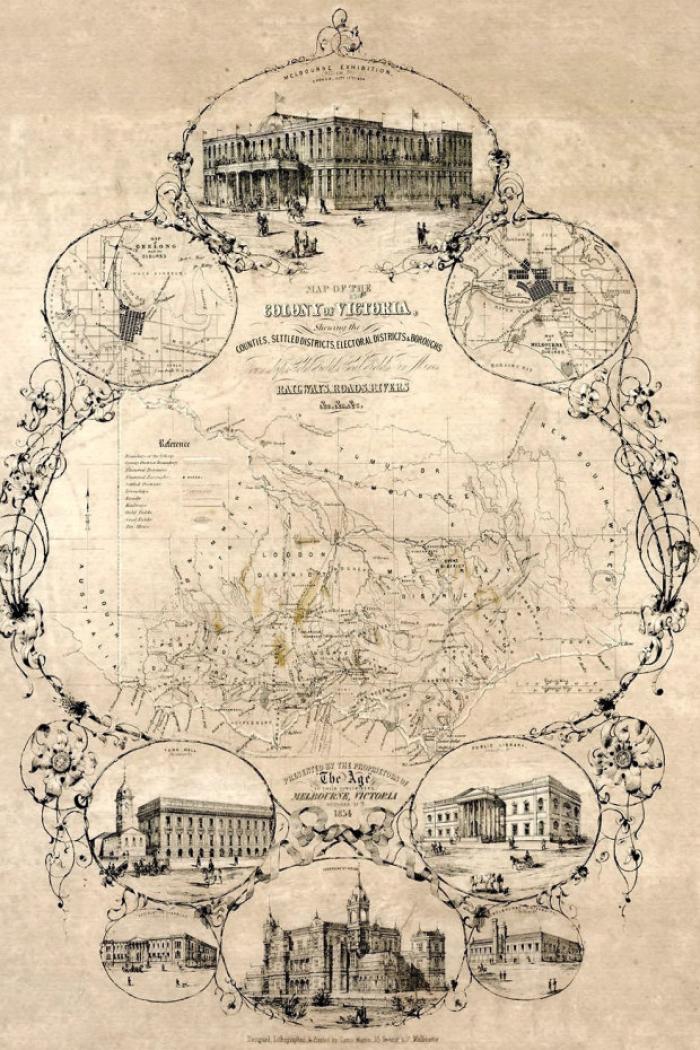
But the census report further noted "the metropolis may practically be considered to comprise the inhabitants of Collingwood, Richmond, Prahran, Flemington, and vessels in the Yarra Yarra, which will make the aggregate population of Melbourne and its suburbs amount to 76,565 persons".
The original inhabitants of the Yarra Valley were of little interest to the census takers, however.
In 1835, John Batman had professed to win ownership of 600,000 acres of Aboriginal land around the current site of Melbourne through a "treaty" with elders of the Kulin Nation, offering as payment rations and trinkets. Over the following 19 years, the Aboriginal peoples' story in Victoria was a vale of tears: disease, massacres by gun and arsenic, the near total loss of ancestral lands and the refuge of alcohol.
"No note appears to have been taken of the aboriginal tribes, with the exception of a very few individuals who were employed on stations, and who are returned accordingly," the 1854 census report stated.
"The estimated number of aborigines [in Victoria] is stated to be about 2500, but no certain information respecting them has been obtained."
The overall population of Victoria was counted as "236,798, of whom 155,876 were males, and 80,900 females; there were 22 persons whose sex was not returned".
The explosion in gold-rush immigration - most of it through Melbourne - and the consequent demand for imported goods, presented Victoria's administrators with their own bottomless gold mine.
Duties were levied on all imported luxuries brought into the suddenly wealthy colony, while a tax was levied on the export of gold. Customs revenue in 1850 was £84,000. In 1854, customs officers collected the same amount in a month.
The gold rush lured hopefuls from around the world: Americans fresh from their own rush in California arrived alongside Germans, Scandinavians, South Africans and Britons, among others.
Thousands of Chinese gold-seekers came, too, most of them from the Guangdong Province of southern China, propelled by poverty and overpopulation.
Melburnians in 1854 could see hundreds of Chinese arrivals walking in single file through the city, their belongings balanced on wooden poles over their shoulders, heading to the village of Flemington, where they proceeded west to Ballarat, or turned north to Beechworth and the Ovens diggings, or north-west to Bendigo and Castlemaine.
Resentment at the Chinese diggers' work ethic, mixed with plain racism, led in 1855 to Victoria's governing authorities slamming on the brakes with a poll tax of £10 per Chinese arrival - with the tax required to be paid by the captains of the ships transporting them.
To avoid the tax, ships carrying Chinese passengers from then on dropped them off in other colonies - in Sydney, Port Adelaide and Robe, South Australia - requiring them to traipse many hundreds of kilometres on foot to the goldfields.
The streets of Melbourne city were "well metalled" and guttered, and the side paths were in the process of being sealed by the end of 1854, with great piles of bluestone assembled throughout the city, according to The Age.
"Not the least singular sight in Melbourne, and one which soonest attracts the attention of new arrivals, is the long procession of water carts unceasingly en route in Elizabeth Street to the temporary water works near the Hobsons Bay Railway terminus ...
A more complete system of supplying water will shortly come into operation, as a capacious reservoir has been constructed on the Eastern Hill which will be supplied from the government water-works at the eastern end of Flinders Street."
This reduced the need for water carts to control dust which plagued Melbourne during dry periods.
But there was still no sewerage system. Boys were paid to scoop up the excrement of horses and bullocks to fertilise gardens, but human waste and the detritus of butchers' shops and the like still flowed in the streets, and parts of Melbourne stank to high heaven.
Nothing could tame low-lying Elizabeth Street when rain fell. It followed an ancient watercourse known to white settlers as Williams Creek.
It ran for less than three kilometres from the soggy pondages of Royal Park and nearby Carlton, sweeping the muck of the growing city to the Yarra. Thousands of corks, testament to the citizenry's thirst for strong drink, floated out of side streets and congealed into a dense bobbing mass between Collins Street and Flinders Lane.
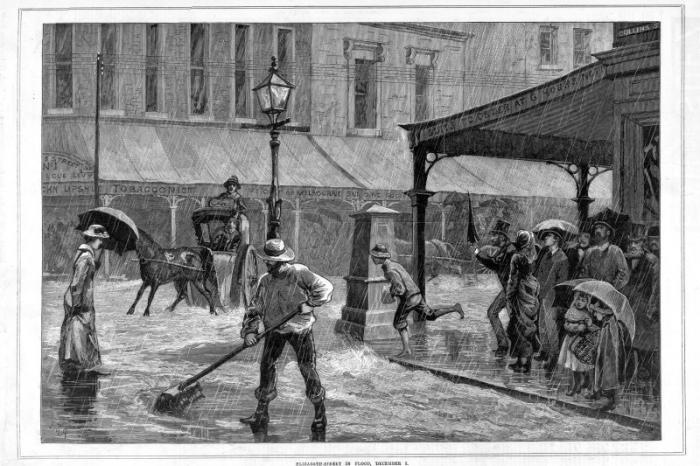
Bullock teams churned the surface to deep mud, and what we know as the corner of Collins and Elizabeth streets often enough became a dangerous swamp.
In 1884, the Melbourne City Council finally set 200 men to work burying the bothersome creek in a four-metre red-brick drain beneath the street, where it has flowed ever since.
The city gets its landmarks
Meanwhile, those concerned that a city should be a cultured place established the Melbourne Museum when its first small display opened in the Government Assay Office in La Trobe Street on March 9, 1854.
Four months later, on July 3, 1854, the new lieutenant-governor of Victoria, Sir Charles Hotham, laid the foundation stone for the State Library on Swanston Street.
On the very same day, Sir Charles and the first chancellor of the University of Melbourne, Redmond Barry, who later sentenced Ned Kelly to hang, laid the foundation stone for the city's new university in Carlton.
It was a frantically busy mid-year.
Downtown, movers and shakers who recognised transport beyond the horse was key to the future opened the first railway station on Flinders Street: a collection of wooden railway sheds.
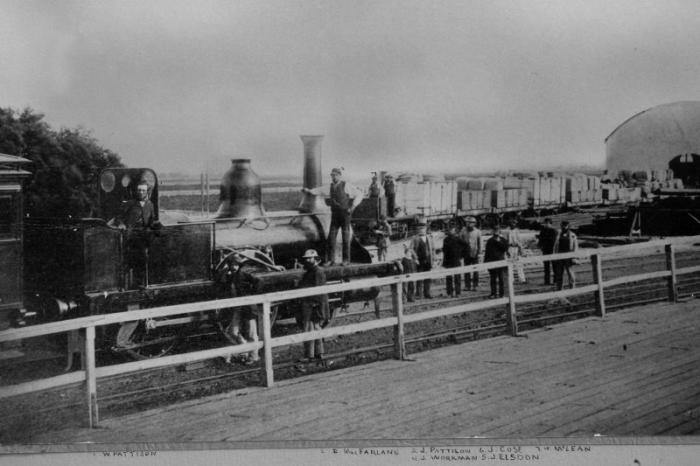
Australia's first steam-powered city train, operated by the Hobsons Bay Railway Company, set off on its first short rail line on June 12, 1854, a full year before Sydney got any form of railway.
The train chuffed from Flinders Street to Sandridge (Port Melbourne), terminating at the newly built pier that became known as Station Pier, where passenger ships disgorged their floods of immigrants, many of them infected with gold fever.
The railway, it happened, cut clean through the cricket ground used by the Melbourne Cricket Club in Sandridge.
1854: The year that shaped Melbourne
Forced to find a new ground, the MCC's well-connected directors turned to the outgoing lieutenant-governor Charles La Trobe. He offered the choice of three sites - next to the existing Sandridge ground; an area at the junction of Flinders and Spring streets; or a space within the Police Paddock at Richmond.
The "police paddock" was an ancient corroboree ground and camping place used by the Wurundjeri people.
The MCC recognised the site's physical - if not its cultural - attributes, declaring "the situation was quite as level as desirable yet afforded sufficient slope that without interfering with the game would ensure its always being free from floods".
And so was born the MCG, today one of the world's great sporting stadiums. The first members' pavilion - a wooden affair capable of accommodating about 60 citizens - was built in 1854.
Melbourne's swelling citizenry - at least, that part of it that could afford a little time off from the business of daily survival - found leisure in the surrounds of the "paddock" and other outdoor areas on the outskirts of town.
"The Richmond Paddock, in particular, is a delightful retreat from the heat, dust, and business of the City," reported The Age in a special report titled "Melbourne in 1854", published in January 1855.
"Nature has made it a beautiful locality, and all that is now required is the hand of man to complete what nature has designed," wrote the anonymous journalist, apparently ignorant of the fact the hand of Indigenous Australia had long played a part in what nature had designed.
"The Melbourne Cricket Club hold their meetings in the [Richmond] paddock ...
Upon grand days ... the scene is very animated from the large concourse of ladies; and when a military band plays, the brilliant company and surrounding scenery forcibly call to mind the attractions of Kensington Gardens ..."
"The planting of a few more trees and the opening of a gravel walk along the margin of the Yarra would greatly tend to enhance the natural beauties of the paddock."
The correspondent was much enthused by open spaces.
"Opposite the paddock, across the Yarra, are the Botanical [sic] Gardens, a favourite place of resort of the Melbournites [sic] on Sundays," he wrote.
"The gardens are laid out with great taste, and shrubs and trees of almost every clime may be seen in full bloom and vigour. The large lake attached to the gardens swarms with wild fowl of every description, which have here a secure retreat from the hands of man."
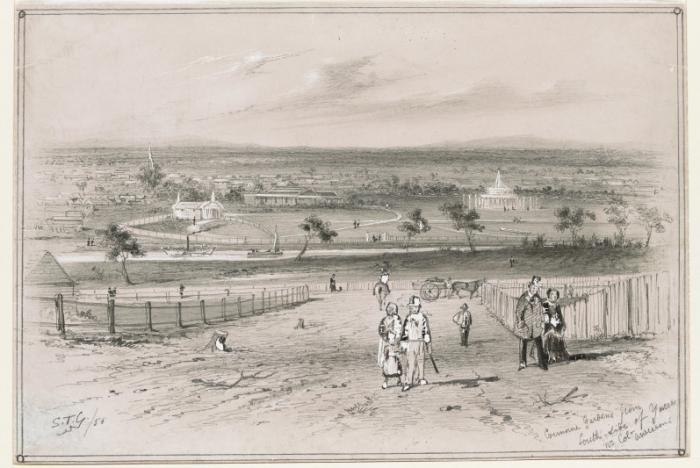
Outings by horse-drawn coach to St Kilda beach were also popular in 1854, though armed bushrangers had held up travellers on the scrubby track that was St Kilda Road in 1852 and 1853.
More favoured still was a boat ride up the Yarra to the fairground known as the Cremorne Gardens, where a dance hall, circus acts, fireworks displays and a performing elephant pulled in the crowds.
The first proprietor, James Ellis, had managed the original Cremorne Gardens on the banks of the Thames River in London, and many Melburnians were entranced at the idea that they had access to a facsimile of such famous entertainment on the banks of their own Yarra.
But Ellis fell afoul of strait-laced Melbourne authorities over liquor laws and for allegedly allowing prostitutes to add to the pleasures of his gardens.
He relinquished his lease in 1855, and the business was later taken on and expanded by theatrical entrepreneur George Coppins. Within a decade, however, the gardens closed.
Cremorne remains today only as the name of a cramped suburb on the old fairground site next to Richmond.
Complaints about Ellis' transgressions of liquor laws and the sex trade seem exotic, considering sly grogging, brothel keeping and "bilking" - the often violent robbery of drunken clients - were rife in the centre of the city.
An area bounded by the east end of Bourke Street through to Little Lonsdale Street was among the most dangerous and depraved areas of Australia in 1850s gold rush Melbourne.
Social historian and author Janet McCalman gives a no-holds-barred description of the area in her book Vandemonians: The Repressed History of Colonial Victoria. She quotes a report compiled towards the end of the 1850s that found of the 500 prostitutes known to police in Melbourne, 200 operated in the area enclosed by Spring, Russell, Bourke and La Trobe streets.
Within the lanes of that small area, the "most abandoned" lived in 106 small brothels. Of the 106, "about 35 were frequented by low thieves, nine by professional burglars, six by sharpers [a term for thieves who used trickery], nine by fighting and fancy men [pimps], two by American coloured men; five by Jew dealers and petty tradesmen; two by foreigners, six by cabmen exclusively; and 22 by bushmen, diggers, employees in business premises, and 'flash' men generally".
The religious and the damned
At the other end of the social scale, churchgoers had no shortage of places at which to worship, though in 1854, the soaring architectural temples were yet to come.
What would eventually rise as St Paul's Anglican Cathedral, on the corner of Flinders and Swanston streets, was a humble St Paul's parish church in 1854.
The Scots Church up the hill was a stone building capable of holding 500 worshippers, but would need to be replaced by 1869 because it was too small, and the steeple had developed an alarming lean.
The Catholics had St Francis' Church on the corner of Lonsdale and Elizabeth streets, their cathedral from the mid-1840s, until St Patrick's Cathedral was built in East Melbourne and was finally consecrated in 1897.
Melbourne's Jewish community opened their second synagogue in Bourke Street, between Queen and William streets, in 1854, replacing a tiny but exquisite building that had been used since 1848.
"Good stone and brick buildings, some of them of elegant and massive proportions, are very numerous, but frequently beside them may be seen wretched little wooden houses, which are not only unsightly, but are the subject of frequent fires. A very stringent building act, however, has been in operation for several years."
Out on Hobsons Bay off Williamstown, however, no merciful deity existed for the hundreds of wretched prisoners housed in five hulks - ships abandoned by gold-rushers and purchased by the government to ease overcrowding of Melbourne Gaol.
They were overseen by a Samuel Barrow, inspector-general of Victoria's Penal Establishments, an unforgiving sadist who'd got his start on Norfolk Island, where he handed out floggings so extreme that convicts' vertebrae were regularly exposed.
His written plan for the hulks was that he wished to forge a "wholesome terror in the minds of prisoners".
The most feared hulk of all was the President, for "intractable prisoners", who would never be allowed ashore for the period of their confinements of 12 months to three years, during which they would be kept always in irons weighing between five and 16 kilograms and often punished for days with a wooden gag that made it difficult to breathe and impossible to eat.
Barrow drowned in May 1854, while boating on Hobsons Bay. He was replaced by an even harsher inspector-general, John Giles Price, who was assaulted with such fury by prisoners at Point Gellibrand, Williamstown, that he died the following day, March 26, 1857.
Other prisoners went to Pentridge, a suburb later renamed Coburg because Pentridge Prison gave it a bad name. Pentridge prisoners in 1854 were required to begin building their own prison, and learnt about hard labour breaking bluestone at the growing number of quarries in the area that produced the stone that built Melbourne's streets and finest structures. What is now Coburg Lake was the main quarry used for stone that built Pentridge Prison.
And so, Melbourne's entrepreneurs, optimists, the blessed, the sinners and the damned laid the makings of the place that became known as Marvellous Melbourne, and whose 5 million residents today can still see the evidence of that extraordinary year, 1854.
By Tony Wright | theage.com.au
October 17, 2024
Tony Wright is the associate editor and special writer for The Age and The Sydney Morning Herald.
❊ Web Links ❊
➼ 1854: The year that shaped Melbourne
Disclaimer: Check with the venue (web links) before making plans, travelling or buying tickets.
Accessibility: Contact the venue for accessibility information.
Update Page








